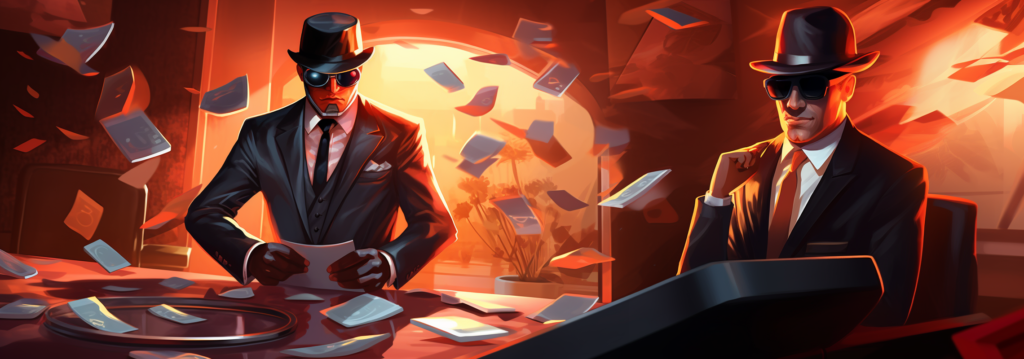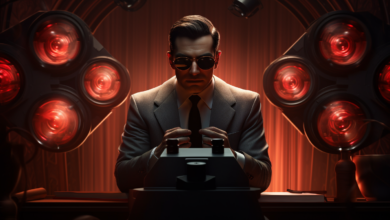
The Art of Blending In: Undercover Spy Tactics for Secret Agents
What does Secret Agent Spy Tactics mean?
Secret Agent Spy Tactics refer to the strategic methods and techniques employed by covert agents to gather intelligence, conduct surveillance, and carry out clandestine operations. These tactics are essential for achieving success in the world of espionage and national security. In this comprehensive guide, we will delve into the various aspects of secret agent spy tactics, their historical significance, their role in national security, and how they are employed by agents in the field.
Main Criteria:
- Secret Agent Spy Tactics encompass a range of techniques used by covert agents.
- These tactics have a rich historical context and are crucial for national security.
- Spy tactics can be broken down and understood in layman terms.
What are Secret Agent Spy Tactics?
A formal definition of Secret Agent Spy Tactics:
Secret Agent Spy Tactics can be defined as a set of strategic methods and techniques used by covert agents to gather intelligence, conduct surveillance, and carry out clandestine operations. These tactics involve a combination of skills, knowledge, and specialized tools to navigate complex situations and obtain critical information.
Historical Context of Spy Tactics:
The origins of secret agent spy tactics can be traced back to ancient times when spies were used as a means of gaining an advantage in conflicts and securing sensitive information. Throughout history, various civilizations have employed espionage as a tool to gather intelligence and stay one step ahead of their adversaries.
Why are spy tactics important?
Spy tactics play a crucial role in national security as they provide vital information about potential threats, enemy activities, and emerging geopolitical developments. By employing these tactics, intelligence agencies and covert operatives can assess risks, prevent attacks, and protect the interests of their respective nations.
Breaking down spy tactics in layman terms:
While spy tactics may seem complex and mysterious, they can be broken down into more understandable terms. At its core, spy tactics involve skills such as disguise, source cultivation, secret communication, physical training, observation, analysis, counterintelligence, operational security, and technical proficiency. These skills collectively enable spies to blend into their surroundings, gather valuable intelligence, and carry out missions undetected.
Importance role of Spy Tactics in national security
The importance of spy tactics in national security cannot be overstated. These tactics serve as the backbone of intelligence gathering and covert operations, providing decision-makers with the information necessary to protect the nation’s interests. By employing spy tactics, agencies can identify potential threats, monitor the activities of hostile actors, and intervene proactively to prevent harm or damage to national security.
Different types of Spy Tactics
Spy tactics encompass a range of techniques that can be categorized into different types based on their purpose and application. Some of the key types of spy tactics include:
- Covert Surveillance: This involves discreetly monitoring individuals, locations, or events to gather intelligence without alerting the targets.
- Human Intelligence (HUMINT): HUMINT involves the collection of information through human sources, such as clandestine agents, informants, or double agents.
- Technical Intelligence (TECHINT): TECHINT focuses on gathering information through the use of technology, such as interception of communication signals or analysis of digital data.
- Sabotage and Subversion: These tactics involve disrupting or undermining the operations of adversary organizations or governments through covert actions.
- Counterintelligence: Counterintelligence tactics are employed to detect, neutralize, and mitigate threats posed by enemy intelligence agencies and spies.
How does a Secret Agent employ Spy Tactics?
A secret agent employs spy tactics by combining skills, knowledge, and specialized tools to carry out covert missions and gather intelligence. The process typically involves careful planning, risk assessment, and execution of tactics tailored to the specific objectives of the mission.
Spy Tactics ranking on the effectiveness scale
The effectiveness of spy tactics can vary depending on various factors such as the skill of the agent, the complexity of the mission, the resources available, and the nature of the target or objective. However, spy tactics are generally considered highly effective when backed by thorough training, meticulous planning, and timely execution.
How to employ Spy tactics: Infiltrating Enemy Lines
1. Master the art of disguise
Successful infiltration often relies on the ability to blend seamlessly into different environments. Mastering the art of disguise involves altering one’s appearance, behavior, and mannerisms to convincingly assume new identities. This can include changing physical appearance, adopting different accents, and behaving in a manner consistent with the desired persona.
How to master disguise
- Study the target environment: Understanding the culture, customs, and appearance of the target environment is crucial for effective disguise.
- Alter physical appearance: Utilize techniques such as prosthetics, wigs, makeup, and clothing to transform your appearance.
- Develop and maintain cover stories: Craft believable background stories that support your new identity.
- Practice acting and behavior: Learn to adopt new accents, behave naturally, and adapt to different social situations.
2. Learn to cultivate sources
Cultivating reliable sources is essential for obtaining valuable intelligence. This involves building interpersonal relationships and gaining the trust of individuals who have access to sensitive information. Developing rapport, maintaining confidentiality, and providing incentives are key aspects of source cultivation. Building trust and nurturing sources over time increases the likelihood of obtaining accurate and actionable intelligence.
3. Master secret communication techniques
Effective secret communication techniques are vital for covert agents to relay information securely and discretely. Techniques such as encryption, codes, ciphers, dead drops, and invisible ink are commonly used to conceal messages and ensure that only the intended recipients can access and decipher the information.
An introduction to secret communication techniques:
- Encryption: The process of converting plaintext into ciphertext to prevent unauthorized access.
- Codes and ciphers: Systems of substituting or rearranging letters or symbols to hide the intended message.
- Dead drops: Concealing and exchanging materials or information at pre-arranged locations without direct contact.
- Invisible ink: Using substances or methods that render writing invisible until treated with a specific reagent.
4. Understand the role of technology in spying
Technology plays a significant role in modern-day espionage, providing agents with advanced tools to gather intelligence and carry out operations. Understanding and utilizing cutting-edge technology is imperative for spies to remain effective in an increasingly connected and digitized world. From surveillance equipment to cyber warfare capabilities, agents need to stay abreast of technological advancements in their field.
The impact of technology on spying:
- Advanced surveillance systems: High-resolution cameras, drones, and satellite imagery provide enhanced visibility and monitoring capabilities.
- Cyber espionage: Utilizing hacking techniques and malware to infiltrate computer networks and access sensitive information.
- Communication interception: Monitoring and intercepting communication channels to gather intelligence on targets.
5. Physical and weapon training
Physical fitness and weapon training are essential for agents to navigate challenging situations and protect themselves during covert operations. Agents must possess the physical stamina, agility, and combat skills necessary to handle unexpected confrontations or escape dangerous situations.
Detailed look at physical and weapon training:
- Fitness and endurance training: Building strength, stamina, and agility through cardiovascular exercises, endurance workouts, and strength training.
- Hand-to-hand combat and self-defense: Learning martial arts, defensive tactics, and techniques to immobilize or disarm opponents.
- Firearms training: Acquiring proficiency in handling and operating firearms safely and effectively.
6. Develop a keen sense of observation and analysis
An agent’s ability to observe and analyze their surroundings is crucial for detecting anomalies, identifying threats, and accurately assessing situations. This skill involves paying attention to detail, recognizing patterns, and interpreting cues to extract meaningful information from the environment.
Here’s how to develop keen observation skills:
- Practice mindfulness: Cultivate a state of heightened awareness and focus to observe your surroundings more effectively.
- Sharpen your senses: Train your eyes, ears, and other senses to pick up on subtle changes or anomalies.
- Analyze patterns and behaviors: Look for patterns, routines, and anomalous behavior that might indicate covert activities or hidden information.
- Enhance memory and recall: Train your memory to retain and recall information accurately and quickly.
7. Understand and learn counterintelligence techniques
Counterintelligence techniques are crucial for protecting undercover agents and confidential information from detection and compromise. By understanding how adversaries operate and employing defensive measures, agents can minimize the risk of their cover being exposed and mitigate threats to their mission’s success.
Deeper look at counterintelligence techniques:
- Surveillance detection: Recognizing and evading surveillance to maintain operational security.
- Deception and misdirection: Misleading adversaries through carefully orchestrated actions and false information.
- Counter surveillance: Monitoring and neutralizing hostile surveillance to prevent detection or compromise.
- Risk assessment and mitigation: Identifying potential risks and taking proactive measures to minimize their impact.
How to employ Spy tactics: Operational security
Operational security, also known as OPSEC, refers to the measures taken to protect sensitive information, maintain secrecy, and minimize the risk of compromise. This includes establishing cover stories, blending with surroundings, and developing evasion and survival strategies.
8. Blend with your surroundings
Blending in with the environment is essential for maintaining covert operations. By adopting the dress, mannerisms, and cultural norms of the target environment, agents can operate unnoticed and avoid drawing suspicion.
9. Evasion and survival strategies
Agents must be prepared to evade capture or navigate hostile situations during their missions. Training in evasion techniques, escape tactics, and survival skills equips agents with the tools to extricate themselves from dangerous situations and return safely.
10. Establish and maintain a cover story
Agents often need to assume new identities and establish cover stories to conceal their true identities and objectives. A well-crafted cover story, rooted in believable background details and supported by documentation, helps agents maintain their covert status while operating undercover.
Technical skills required for effective Spy Tactics
In addition to the aforementioned tactical skills, secret agents must also possess technical abilities relevant to their field. These skills include proficiency in areas such as cryptography, cyber security, surveillance technology, communications systems, and explosives handling. Staying abreast of technological advancements and continuously honing these technical skills is imperative for agents to adapt to evolving threats and maintain their effectiveness in the field.
Tools and gadgets used in Spy Tactics
Secret agents rely on a variety of tools and gadgets to facilitate their missions and gather intelligence. These can range from concealed recording devices and miniature cameras to night vision goggles, lock-picking tools, and encrypted communication devices. The availability and sophistication of these tools have evolved significantly over time, enabling agents to operate covertly and securely.
Spy strategies and best practices
Successful spy operations are often the result of meticulous planning, effective execution, and adherence to best practices. Employing strategic thinking, leveraging intelligence assets, maintaining operational security, and constantly adapting to changing circumstances are vital components of successful spy strategies. By adopting best practices and continuously improving their skills, secret agents can enhance their chances of accomplishing their missions and ensuring national security.
Wrap Up
Secret Agent Spy Tactics encompass a broad range of techniques and skills that are essential for intelligence gathering, surveillance, and covert operations. These tactics are of paramount importance in safeguarding national security and protecting the interests of nations. By understanding and employing spy tactics effectively, covert agents can operate in secret, gather valuable intelligence, and contribute to the overall security and well-being of their nations.














